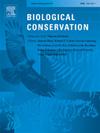Climatic drought and trophic disruption in an endemic subalpine Hawaiian forest bird
IF 4.9
1区 环境科学与生态学
Q1 BIODIVERSITY CONSERVATION
引用次数: 0
Abstract
Overexploitation, habitat conversion, and introduced species have caused unprecedented extinctions and heavily degraded native bird populations in island ecosystems. In the Hawaiian Islands, stemming these losses has proven difficult as the highly specialized avifauna are often impacted – among other things – by poorly understood trophic disruptions as well as persistent climatic shifts. Here we investigate these dynamics by examining the trophic positions of 7 different taxa of producers and consumers across the last century in the subalpine māmane (Sophora chrysophylla) forest ecosystem on the island of Hawaiʻi. From museum collections and contemporary sampling, we analyzed the stable nitrogen (δ15N) values of producers and consumers to identify trophic and source amino acids and derive trophic enrichment constants specific to this food web. This enables us to reconstruct the diet of the palila (Loxioides bailleui), a critically endangered finch whose population recently declined 90 %. Our results show that from 1890 to 2006, the palila trophic position declined from 2.6 to 2.2, with cascading implications for its diet. Bayesian mixing model reconstructions indicate that palila trophic position changes likely arose from a 76 % decline (69.3 % to 16.6 % of diet) in the consumption of native moth caterpillars, and a 172 % increase (30.7 % to 83.4 %) in native plants. From the available ecosystem variables, exploratory Bayesian multiple regressions selected surface temperature changes, and the interactions of surface temperatures with drought and caterpillar parasitism as the primary drivers of these trophic changes. Despite the predicted increases of warming and drought, management interventions may build resiliency in this unique island ecosystem.
夏威夷亚高山森林特有鸟类的气候干旱和营养障碍
过度开发、栖息地转换和引进物种造成了前所未有的鸟类灭绝,并使岛屿生态系统中的本地鸟类种群严重退化。在夏威夷群岛,由于高度专业化的鸟类经常受到人们知之甚少的营养干扰和持续的气候变化等因素的影响,要阻止这些损失已被证明是很困难的。在这里,我们通过考察上个世纪夏威夷岛亚高山马曼尼(Sophora chrysophylla)森林生态系统中 7 个不同类群的生产者和消费者的营养状况来研究这些动态。通过博物馆藏品和当代取样,我们分析了生产者和消费者的稳定氮(δ15N)值,以确定营养氨基酸和来源氨基酸,并推导出该食物网特有的营养富集常数。这使我们能够重建棕榈雀(Loxioides bailleui)的食物结构,棕榈雀是一种极度濒危的雀类,其数量最近下降了 90%。我们的研究结果表明,从1890年到2006年,棕榈鸦的营养级从2.6级下降到2.2级,对其食物产生了连锁影响。贝叶斯混合模型重建表明,棕榈鸦营养位置的变化可能是由于食用本地蛾类毛虫减少了 76%(占食物的 69.3% 降至 16.6%),而食用本地植物增加了 172%(占食物的 30.7% 升至 83.4%)。从可用的生态系统变量中,探索性贝叶斯多元回归选择了地表温度变化以及地表温度与干旱和毛虫寄生的交互作用作为这些营养变化的主要驱动因素。尽管预计气候变暖和干旱会加剧,但管理干预措施可能会增强这一独特岛屿生态系统的恢复能力。
本文章由计算机程序翻译,如有差异,请以英文原文为准。
求助全文
约1分钟内获得全文
求助全文
来源期刊

Biological Conservation
环境科学-环境科学
CiteScore
10.20
自引率
3.40%
发文量
295
审稿时长
61 days
期刊介绍:
Biological Conservation is an international leading journal in the discipline of conservation biology. The journal publishes articles spanning a diverse range of fields that contribute to the biological, sociological, and economic dimensions of conservation and natural resource management. The primary aim of Biological Conservation is the publication of high-quality papers that advance the science and practice of conservation, or which demonstrate the application of conservation principles for natural resource management and policy. Therefore it will be of interest to a broad international readership.
 求助内容:
求助内容: 应助结果提醒方式:
应助结果提醒方式:


